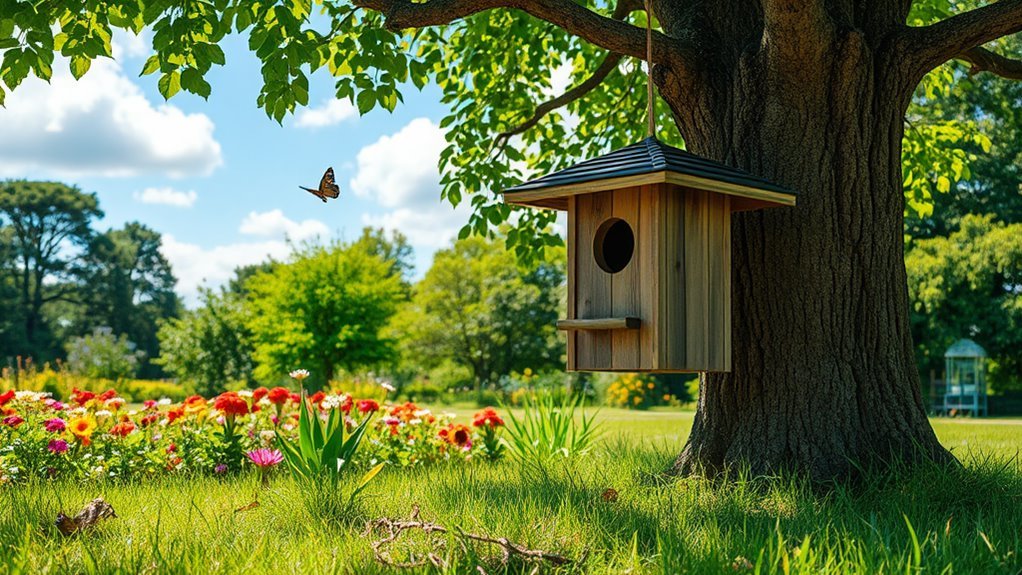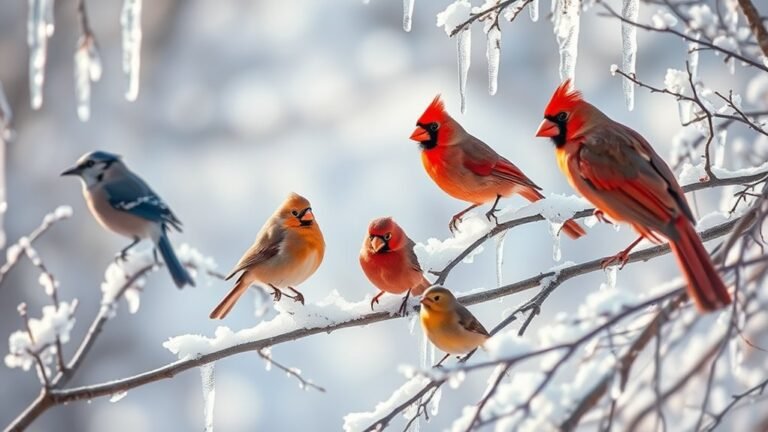Where Should I Place My Bird House For Best Results?
Placing your birdhouse correctly is important for attracting and housing birds. Consider these factors: height, sunlight exposure, and distance from food sources. Each factor helps birds feel safe and comfortable. Knowing these preferences can improve your chances of success.
Here are some simple strategies for birdhouse placement:
- Height: Mount your birdhouse at the right height for your target species. Most birds prefer heights between 5 to 10 feet.
- Sunlight: Position the birdhouse in a location that receives some morning sunlight but is shaded during the hottest part of the day. This helps keep the interior cool.
- Food Sources: Place the birdhouse near natural food sources like trees, shrubs, or bird feeders. This makes it easier for birds to find food.
- Protection: Ensure the birdhouse is away from strong winds and predators. A sheltered spot can provide safety for the birds.
- Accessibility: Choose a location that is easy for you to access for cleaning and maintenance.
By following these guidelines, you can create a welcoming environment for birds in your area. Enjoy observing the birds that come to your birdhouse!
Key Takeaways
- Install birdhouses 5 to 10 feet above the ground. This height keeps birds safe from predators.
- Choose a location that gets morning sunlight and afternoon shade. This helps regulate temperature and keeps the birds comfortable.
- Place birdhouses near natural cover like trees or shrubs. Avoid dense bushes that may hide predators.
- Position birdhouses close to food and water sources, such as flowering plants and birdbaths. This attracts a variety of bird species.
- Learn about local bird species and their nesting needs. Adjust the placement of your birdhouses to attract them effectively.
Understanding Bird Preferences
To attract birds to your yard, understand their preferences. Different bird species have specific nesting habits that affect where they like to settle. For example, some birds prefer cavities in trees, while others choose open spaces or shrubs.
To create an inviting space, identify the types of birds in your area and their needs. Research common species and their nesting habits. This knowledge will help you decide where to place birdhouses.
The surrounding environment is also important. Birds are attracted to areas with enough food and shelter.
Choosing the Right Height
Selecting the right height for your birdhouse is important because it affects which birds will use it. The ideal height is usually between five and ten feet above the ground. This range keeps the birdhouse safe from predators while still being accessible for birds that want to nest.
Different bird species have their preferences; for example, bluebirds like lower spots, while wrens tend to choose higher places.
When deciding where to place your birdhouse, think about the surrounding area. Mount the birdhouse securely to ensure it remains stable, which is crucial for attracting birds.
Positioning the birdhouse near natural cover, such as trees or shrubs, can also improve your chances of attracting residents. By carefully selecting the height and location of your birdhouse, you can create a welcoming home for birds and enjoy the beauty of nature in your backyard.
Considering Sunlight and Shade
Choosing the right spot for your birdhouse involves considering sunlight and shade. These factors affect the comfort and safety of birds.
Place the birdhouse where it gets morning sun and afternoon shade. This setup helps keep the temperature stable and the nesting materials dry.
Too much sun can overheat the birdhouse, while too much shade may keep away some birds that like sunny areas.
Observe how sunlight moves across the area during the day. By taking these factors into account, you'll create a friendly space for birds to nest, enhancing your garden's appeal.
Avoiding Predators
To keep your birdhouse safe for birds, you need to prevent predators. Start by placing your birdhouse 5 to 10 feet off the ground. This height will help keep raccoons and cats away.
Choose birdhouses with narrow openings that fit the birds you want to attract. This makes it harder for larger predators to enter.
Avoid putting your birdhouse near thick bushes or trees, as they can hide potential threats.
Lastly, clear away debris and nesting materials around the birdhouse. This will help stop predators from being drawn to the area.
Selecting the Ideal Location
Finding the right location for your birdhouse is essential for attracting different bird species. Birds have specific nesting habits; some like to nest high, while others prefer lower spots.
Watch the birds in your area to see what trees or shrubs they favor.
Place your birdhouse in a quiet area, far from busy paths. This keeps the birds safe while they nest.
Choose a spot that offers some shade to help regulate temperature and protect them from harsh weather.
Proximity to Food and Water Sources
Choosing a birdhouse site close to food and water sources increases your chances of attracting birds. Birds need these resources to survive.
Place your birdhouse near natural food sources like flowering plants, berry bushes, or bird feeders to make it more appealing. This way, birds can find food easily and feel safe while nesting.
Additionally, having water sources nearby, such as birdbaths or ponds, provides hydration for the birds and attracts different species.
Ensuring Accessibility for Birds
To attract birds to your garden, it's important to ensure that the birdhouse is easy for them to access.
Different bird species have different preferences for nesting sites. Some birds like to nest low, while others prefer high locations.
Place the birdhouse in a clear flight path, away from dense plants that could block access.
Check that the entrance hole is the right size for the bird species you want to attract, as this affects their willingness to enter.
By paying attention to these details, you can create a welcoming environment for birds, helping them feel at home in your garden.
Making the birdhouse accessible is key to attracting and supporting a variety of bird species.
Monitoring Surrounding Vegetation
To attract birds, monitor the plants around your birdhouse. The right vegetation can improve the environment, making it a better nesting area.
Here are some important factors to consider:
- Variety of Plants: Different plants attract various bird species and meet their food needs.
- Habitat Layers: Include trees of different heights, shrubs, and ground cover to offer shelter and foraging spots.
- Use Native Plants: Choose local plants to draw in native birds and support the ecosystem.
Seasonal Considerations for Placement
Understanding seasonal changes in your area is important for birdhouse placement.
In spring, place your birdhouse in a sunny, sheltered spot to attract migratory birds looking for nesting sites. Choose a location near food sources, like flowers or shrubs, to encourage birds to stay.
As winter approaches, move your birdhouse to provide winter shelter. A protected area, such as near dense foliage or away from strong winds, can help birds survive colder months.
Ensure your birdhouse is insulated and waterproofed for year-round use. By adjusting your birdhouse placement according to the seasons, you create a welcoming environment that supports local bird populations.
Frequently Asked Questions
What Materials Are Best for Constructing a Birdhouse?
When building a birdhouse, choose strong woods like cedar or pine. These materials last a long time. For insulation, use straw or shredded paper. These options help keep the temperature comfortable, creating a safe space for birds. Enjoy watching the birds as they settle into their new home!
How Often Should I Clean My Birdhouse?
You should clean your birdhouse at least twice a year. This will help keep it in good condition. Regular cleaning stops parasites and diseases, making the birdhouse a safe place for birds. A clean birdhouse encourages birds to return to your yard.
Can I Paint My Birdhouse, and What Colors Are Safe?
You can paint your birdhouse. Use non-toxic, water-based paints. Bright colors attract birds and make the birdhouse look good. Softer tones create a calm space for birds. Choose colors that will welcome your feathered visitors.
What Are the Best Birdhouse Designs for Specific Bird Species?
When choosing birdhouse designs, make sure bluebird houses have larger entrances. In contrast, wren boxes should have smaller openings. This approach helps attract the right birds to your yard, creating a friendly space for them.
How Can I Attract Birds if They Avoid My House?
If birds avoid your house, you can attract them by providing bird food and nesting materials nearby. Create a friendly environment by placing feeders and natural resources close to your home. This will encourage birds to explore your yard and feel comfortable visiting your space. By making your area inviting, you increase the chances of attracting more birds to your home.

Ava is a bird enthusiast and nature lover who has spent countless hours observing and learning about the fascinating world of birds. With a passion for sharing her knowledge and inspiring others to appreciate the beauty of birds, Ava writes about her experiences and insights on avianadmirer.com.







